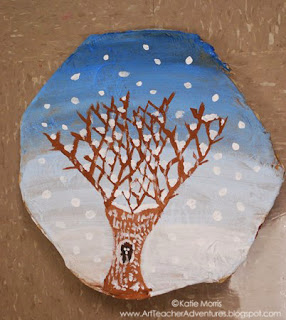Shield- A broad piece of armor worn on the arm to protect against
weapons.
Though shields are primarily designed for physical protection, many are decorated with emblems or symbols for spiritual protection or to represent one’s self or family.
When the art teachers in my district visited the Nelson-Atkins museum of Art last spring to prepare for our Native American focus during Cultural Heritage Week, the curator of the American Indian gallery stated that he thought THIS shield was his favorite piece in the collection. You can follow the link to see a photo and hear the short description that goes with the piece. I knew that shields would be popular with my 6th grade students, but I didn't want to just imitate the piece. Instead, we talked about ideas of protection, representation, and symbolism. The shield would have offered physical protection to the bearer, but the buffalo was more for spiritual protection.
We talked about the buffalo shield, and also looked at shields from Medieval Europe with family crests and shields from tribes in Africa, like the Maasai. The students started by creating a shield base. I had a student video my demo. Some students chose to try the project on the first day, some never tried it, and some tried it in later class periods. The students who started after the first day were shown the video demo so I didn't have to repeat it 20 times. I tried to post the video to YouTube but kept getting errors from iMovie. Tried to post it here and it just shows stills. I'll try to solve the problem later!
Since the video doesn't work, or if you prefer written directions anyway, here are the steps:
- Bend a wire hanger into a shield shape. I use the "bow and arrow" method to stretch it out.
 When the shields were dry in the next class period, the students started to plan their designs. I asked them to create a design with a symbol or emblem to protect or represent. When they were ready to add the design, some students drew and painted directly on the shield while others painted a background color and "mod podged" their design on top.
When the shields were dry in the next class period, the students started to plan their designs. I asked them to create a design with a symbol or emblem to protect or represent. When they were ready to add the design, some students drew and painted directly on the shield while others painted a background color and "mod podged" their design on top.
There were several projects going on in the art room at the same time since we're experimenting with choice-based art. To help keep the various white liquids separate, I used a dry erase marker to label them. It wipes right off when you're finished!
 When students were finished painting, they filled out an artist statement form about their project. This is something we're working on- writing complete sentences, thinking about the questions instead of just writing something like "I don't know" or "I just did it", etc. I really like reading what the students write about their work.
When students were finished painting, they filled out an artist statement form about their project. This is something we're working on- writing complete sentences, thinking about the questions instead of just writing something like "I don't know" or "I just did it", etc. I really like reading what the students write about their work.It may not seem like there was a lot of thought put in to every shield, but the students obviously picked or created symbols that resonate with them. I think that's pretty important.
 |
| Creeper... |
 |
| the Moon! |
 |
| There's a thought bubble that says "Stop, Don't bully!" |
This student skipped the Mod Podge step and just painted directly on the newspaper wrapped around the hanger. It worked a lot better than I expected it to, probably because he was careful to not use too much water. We put a layer of Mod Podge over the top to seal it and lend some strength.
This project was a big hit. Students from lower grades asked about doing it, but I honestly don't know if they could handle it. A lot of the 6th graders had a hard time shaping the wire hangers. It could be that the hangers were heavy-duty. It could also be that "kids these days" don't have much prehensile strength from everything being digital touch screen, etc. and never developed it. I don't know, but I think more bending/squishing/manipulating things projects are in order to help correct the problem!















No comments:
Post a Comment